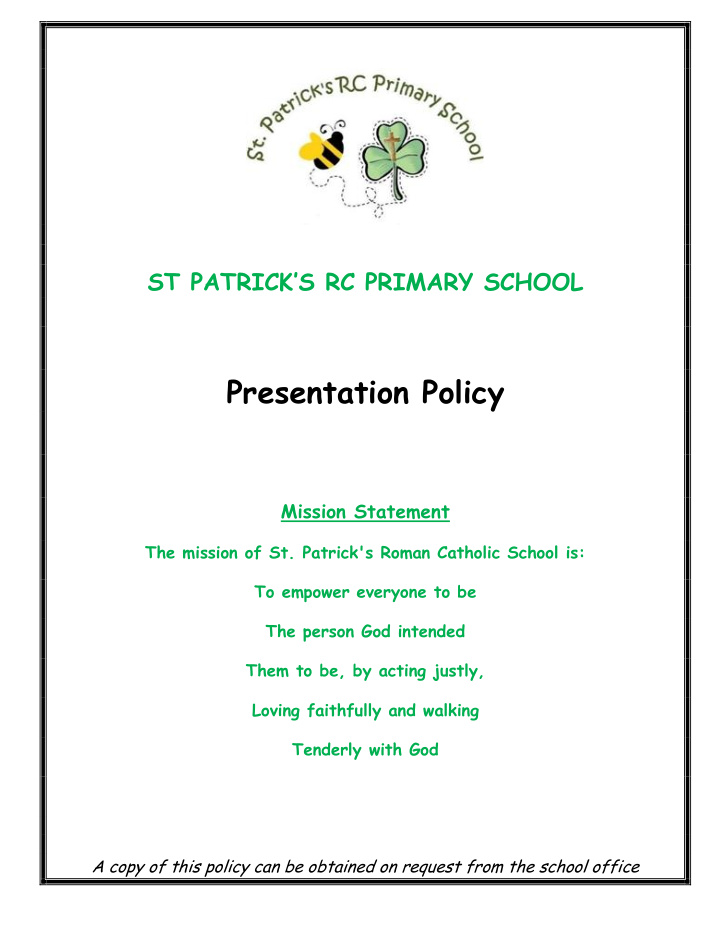



ST PA TRICK’S RC PRIMARY SCHOOL Presentation Policy Mission Statement The mission of St. Patrick's Roman Catholic School is: To empower everyone to be The person God intended Them to be, by acting justly, Loving faithfully and walking Tenderly with God A copy of this policy can be obtained on request from the school office
PRESENTATION POLICY PURPOSE The purpose of this policy is to ensure a consistently high standard of presentation across the whole school which all children and staff recognise, understand and follow. This policy is to be used in line with the individual guidance for each class which outlines the expectations and progression throughout school. APPLICATION These expectations are intended to apply to the vast majority of children in our school. Occasionally a decision will need to be made to personalise the presentation expectations for a child who has such specific needs that these expectations could be a barrier to their progress (e.g. a child with physical difficulties writing). CONSISTENCY AND CELEBRATION Staff will ensure that presentation of work is actively taught. It should be a main focus at the start of each academic year and then be referred to frequently. Where possible, all staff should ensure that presentation is celebrated through: • Displaying work with a high standard of presentation • Celebratin g work with a high standard of presentation in whole class situations. • Ensure good presentation is rewarded in line with whole school behaviour policy (praise, Presentation badges and Head teacher awards) • Sharing of good work in whole school assemblies . • Electronic visualisers (if available) will be used in each class and the hall to enable work to be viewed on interactive whiteboards • Handwriting will be taught in line with the handwriting policy on a regular (at least weekly) basis from Year Reception to Year 6. The focus of these lessons will be correct letter formation and cursive handwriting. EXPECTATIONS FOR TEACHING AND SUPPORT STAFF • Our staff are the most important role models for presentation and high expectations! They should use the resources available (eg. on the IWB – lines, grids) to model good practice. • All handwriting which is on display for the children – on the interactive whiteboard, books, flip charts, display – should be legible, consistently formed and where appropriate joined. • When sticking work/labels/headings in books ensure they are straight and cut to size.
• All photocopied sheets or information given to children should be of the highest quality. Teachers should inform children, through their marking, if presentation is not meeting excepted standards. GENERAL RULES EYFS /KS1 • The children should be taught to hold a pencil correctly. • The children will write and draw in pencil. • The children will use colouring pencils in their books. • Correction pens should not be used by children. • Rubbers shall be used at the teachers discretion. KS2 • The children should write in pencil until they can write in a legible cursive style. • A pen licence will be given to children who have progressed to using a pen. • School pens in blue ink should be used. • The children will respond to comments from the teacher and make improvement to their work in red pen. • Felt pens and gel pens should not to be used in exercise books. • Correction pens should not be used by children. • Rubbers shall be used at the teachers discretion. • As the children move through KS2 if a mistake is made they should be encouraged to draw one neat line using a ruler through the mistake and start again. They should not over-write. • When a child has achieved a pen licence they will have a choice as to whether they write in pen or pencil but pen will be used by all Year 6 in the summer term to get them ‘Secondary school ready’. • There should be no writing or doodling on covers or on the inside covers of books. EXPECTATIONS FOR HANDWRITING • The Penpals scheme is the agreed scheme for teaching handwriting. • Handwriting is taught for at least 15 minutes per week. • Correct handwriting should be re-enforced in all lessons and celebrated. STARTING NEW WORK • Children will leave two lines before starting a new piece of work if there is more than half a page blank. If there is less than half a page blank then the children should start on a new page.
LAYOUT OF WORK EYFS /KS1 • Children will record their work according to their stage of development. • In Year 1 & 2 learning intentions will be stuck in the children’s books for each lesson. • By the end of year 2 they should have started to use the DUMTUMS model for starting work. • They should be taught to write on the lines in their books. • They should be taught to write numbers inside squares. KS2 • All children will set out work in the same way using DUMTUMS (Date, Underline, Miss a line, Title or Learning objective, Underline, Miss a line, Start • The full date should be written at the top left hand side of the page. • In mathematics and science the date should be written in figures. • Children should write on the lines and numbers should be written inside squares. • If appropriate pages can be divided in to two by folding the page vertically in half. • Each calculation must be clearly numbered with a number or letter to distinguish it from working figures. Monitoring Presentation will be monitored by the Senior Leadership Team, Subject leaders and link Governors on a regular basis through: • Work Scrutin ies/moderations • Lesson Observations • ‘Celebration of Work’ meeting s • Pupil interviews Date Agreed: September 2015 Review Date : September 2017 St. Patrick’s Staff 2015
Recommend
More recommend